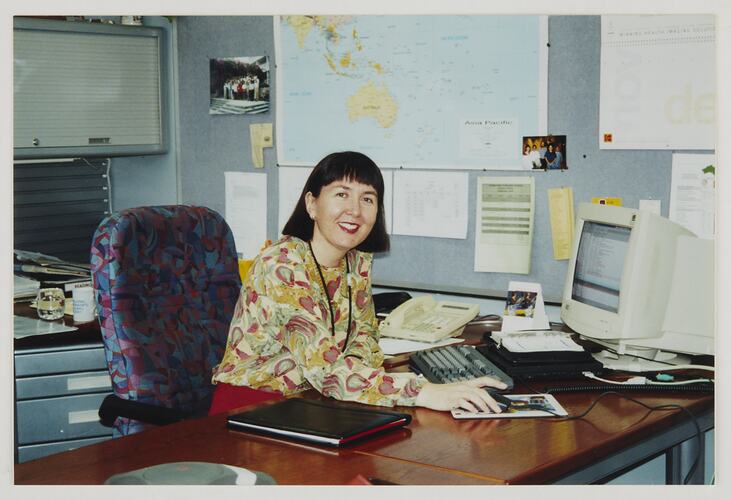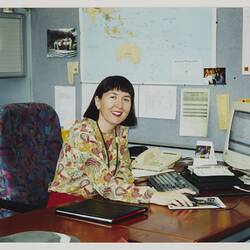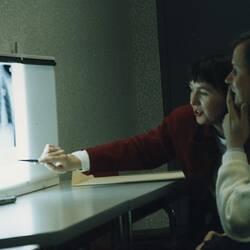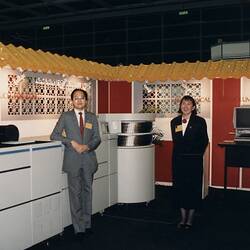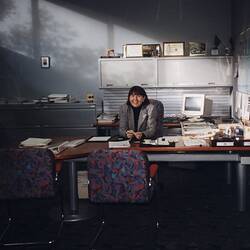Summary
From IT department to General Manager, 1982-2008
Elizabeth Delahunty, Kodak Australasia Pty Ltd: From Computer Programmer to General Manager Kodak Health Asia Region, 1982 - 2008
When Elizabeth Delahunty completed her degree in computer science in 1981, she wasn't sure where it would lead. There was a great demand for computer science graduates at the time, and Elizabeth chose a job at Kodak Australasia, partly because it offered opportunities to travel. Kodak was renowned for its range of photographic film products, including microfilm and microfiche for record storage, and x-ray film. She did not know then that within a decade, Kodak would embrace digital technology for its business imaging and medical markets.
IT Department
Elizabeth commenced work as a computer programmer in the IT department at Kodak's Coburg plant in 1982. Her job was to develop systems for Kodak's finance, administration and payroll 'so that people could work more effectively in their roles'. For five years she built her career in IT, progressing to systems programmer, then systems analyst.
Kodak Business Imaging
In 1987 Elizabeth joined the Business Imaging Division (later called Document Imaging) as a senior systems engineer. Kodak was beginning the change from film-based record storage to digital technology, providing optical discs for storage and electronic systems for indexing and retrieval. Elizabeth's role was to understand clients' needs at the pre-sales stage, configure software to meet customer requirements and provide after-sales service regarding any software problems. This was an opportunity for Elizabeth to hone her IT skills, but it was also the beginning of her transition from a technical role into a role that focused more on customers. Elizabeth observes:
'I probably learnt more about computers in the Business Imaging Department where I was going out on site working with clients, ranging from all of the major banks ... in their computer rooms and working with their teams to make sure these systems were operating well. ... I really found my niche. It was what I enjoyed doing, going out on site, dealing with the clients, travelling around Australia and New Zealand.'
Elizabeth also worked collaboratively with a large computer hardware firm to sell systems to hospitals and pathology clinics.
Kodak Health
In 1992 the Kodak Health Group was gearing up to assist hospitals with the transition to digital imaging. The group enjoyed a good relationship with clients, including large hospitals and radiology clinics, and were experts in x-ray film technology. They needed to add digital expertise to their team, so Elizabeth was appointed Manager of Digital Imaging Solutions. Her job involved visiting hospital radiology departments to learn about their procedures and requirements, in much the same way as she had previously worked with Office Imaging clients.
New imaging technology included computed radiography, which enabled an x-ray image to be displayed almost immediately on a computer screen at a remote location. Kodak also began developing digital systems for organising workflows and information systems in radiology departments. These were known as Radiology Information System (RIS) and Picture Archiving and Communications Systems (PACS).
Kodak Health faced an increasingly competitive market. Their traditional competitors in the x-ray film market, Agfa and Fuji, were moving into digital health imaging systems, as were the manufacturers of modality imaging equipment, such as Siemens, GE and Philips. Nevertheless there was a rapidly growing market in the Asia Pacific region for Kodak Health products and services. In 1994 Elizabeth set up the Digital Solutions and Marketing Group for Kodak Health to provide marketing and technical support for Kodak Health's Asia Pacific region. She found it exciting getting to know the Asian market.
Elizabeth spent 1997 in Canada in a management development role as Director Strategic Planning for Kodak Health. She returned to Melbourne as General Manager of Kodak Health for Australia and New Zealand, eventually progressing to the role of General Manager of Kodak Health for the Asia Pacific region in 2006.
Essentially the change to digital technology meant the change from supplying goods - mainly film and processing chemicals - to services - software and systems development. As a software specialist, Elizabeth was the first person without an engineering background to run the regional services business:
'That was an experiment to really understand what we could do with the services business to make sure it was going to be a viable business as we moved to digital. And through that period of time across Asia Pacific, which included Australia New Zealand, we tripled the size of that business and we also significantly increased the profits of that business, because we were able to start providing software solutions and software service to our clients as well.
So Health, I always felt, was a jewel in the crown for Kodak... It had successfully made the transition to digital. We still had some analogue products, but we were well on the path to digital. We were competing successfully in the market.'
Carestream Health
In 2007 Kodak sold its global Health Group to Onex, a Canadian firm, which set up a new company called Carestream Health. Carestream took over all of Kodak Health's assets and offered to retain all of its staff and their entitlements. Elizabeth was pleased that one hundred percent of the staff in her region transferred from Kodak to Carestream, as did one hundred percent of the clients. She continued for a year as General Manager Carestream Health Asia Pacific, working in Melbourne.
In 2008 Elizabeth resigned to pursue other interests. She later became CEO of COMRAD, a provider of Radiogy Information Systems.
References
Beale, Nigel, 'The History of Kodak in Australia', 1983 (unpublished manuscript), Museums Victoria Kodak collection.
HT 39812 - Oral History Interview with Elizabeth Delahunty, interviewed by Lesley Alves 3 March 2015.
More Information
-
Keywords
Manufacturing, Photographic Products, Biographies, Managers, Accounting
-
Authors
-
Article types
